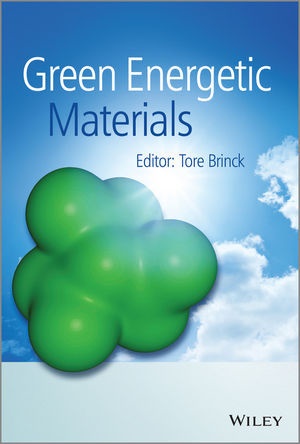Read more
Since the end of the 20th century it has been increasingly realised that the use, or production, of many energetic materials leads to the release of substances which are harmful to both humans and the environment. To address this, the principles of green chemistry can be applied to the design of new products and their manufacturing processes, to create green energetic materials that are virtually free of environmental hazards and toxicity issues during manufacturing, storage, use and disposal. Active research is underway to develop new ingredients and formulations, green synthetic methods and non-polluting manufacturing processes.
Green Energetic Materials provides a detailed account of the most recent research and developments in the field, including green pyrotechnics, explosives and propellants. From theoretical modelling and design of new materials, to the development of sustainable manufacturing processes, this book addresses materials already on the production line, as well as considering future developments in this evolving field.
Topics covered include:
* Theoretical design of green energetic materials
* Development of green pyrotechnics
* Green primary and secondary explosives
* Oxidisers and binder materials for green propellants
* Environmentally sustainable manufacturing technologies for energetic materials
* Electrochemical methods for synthesis of energetic materials and waste remediation
Green Energetic Materials is a valuable resource for academic, industrial and governmental researchers working on the development of energetic materials, for both military and civilian applications.
List of contents
List of Contributors ix
Preface xi
1 Introduction to Green Energetic Materials 1
Tore Brinck
1.1 Introduction 1
1.2 Green Chemistry and Energetic Materials 2
1.3 Green Propellants in Civil Space Travel 5
1.3.1 Green Oxidizers to Replace Ammonium Perchlorate 6
1.3.2 Green Liquid Propellants to Replace Hydrazine 8
1.3.3 Electric Propulsion 10
1.4 Conclusions 10
References 11
2 Theoretical Design of Green Energetic Materials: Predicting Stability, Detection, and Synthesis and Performance 15
Tore Brinck and Martin Rahm
2.1 Introduction 15
2.2 Computational Methods 17
2.3 Green Propellant Components 20
2.3.1 Trinitramide 20
2.3.2 Energetic Anions Rich in Oxygen and Nitrogen 24
2.3.3 The Pentazolate Anion and its Oxy-Derivatives 27
2.3.4 Tetrahedral N4 33
2.4 Conclusions 38
References 39
3 Some Perspectives on Sensitivity to Initiation of Detonation 45
Peter Politzer and Jane S. Murray
3.1 Energetic Materials and Green Chemistry 45
3.2 Sensitivity: Some Background 46
3.3 Sensitivity Relationships 47
3.4 Sensitivity: Some Relevant Factors 48
3.4.1 Amino Substituents 48
3.4.2 Layered (Graphite-Like) Crystal Lattice 49
3.4.3 Free Space in the Crystal Lattice 50
3.4.4 Weak Trigger Bonds 50
3.4.5 Molecular Electrostatic Potentials 51
3.5 Summary 56
Acknowledgments 56
References 57
4 Advances Toward the Development of "Green" Pyrotechnics 63
Jesse J. Sabatini
4.1 Introduction 63
4.2 The Foundation of "Green" Pyrotechnics 65
4.3 Development of Perchlorate-Free Pyrotechnics 67
4.3.1 Perchlorate-Free Illuminating Pyrotechnics 67
4.3.2 Perchlorate-Free Simulators 72
4.4 Removal of Heavy Metals from Pyrotechnic Formulations 75
4.4.1 Barium-Free Green-Light Emitting Illuminants 76
4.4.2 Barium-Free Incendiary Compositions 78
4.4.3 Lead-Free Pyrotechnic Compositions 80
4.4.4 Chromium-Free Pyrotechnic Compositions 82
4.5 Removal of Chlorinated Organic Compounds from Pyrotechnic Formulations 83
4.5.1 Chlorine-Free Illuminating Compositions 83
4.6 Environmentally Friendly Smoke Compositions 84
4.6.1 Environmentally Friendly Colored Smoke Compositions 84
4.6.2 Environmentally Friendly White Smoke Compositions 88
4.7 Conclusions 93
Acknowledgments 94
Abbreviations 95
References 97
5 Green Primary Explosives 103
Karl D. Oyler
5.1 Introduction 103
5.1.1 What is a Primary Explosive? 104
5.1.2 The Case for Green Primary Explosives 107
5.1.3 Legacy Primary Explosives 108
5.2 Green Primary Explosive Candidates 110
5.2.1 Inorganic Compounds 111
5.2.2 Organic-Based Compounds 116
5.3 Conclusions 125
Acknowledgments 126
References 126
6 Energetic Tetrazole N-oxides 133
Thomas M. KlapEURotke and JEURorg Stierstorfer
6.1 Introduction 133
6.2 Rationale for the Investigation of Tetrazole N-oxides 133
6.3 Synthetic Strategies for the Formation of Tetrazole N-oxides 136
6.3.1 HOF CH3CN 136
6.3.2 Oxone1 137
6.3.3 CF3COOH/H2O2 138
6.3.4 Cyclization of Azido-Oximes 139
6.4 Recent Examples of Energetic Tetrazole N-oxides 139
6.4.1 Tetrazole N-oxides 140
6.4.2 Bis(tetrazole-N-oxides) 150
About the author
Professor Tore Brinck, KTH - Royal Institute of Technology, School of Chemical Science and Engineering, SwedenTore Brinck received his Ph.D. in Chemistry in 1993 from the University of New Orleans. He was appointed full Professor of Physical Chemistry at the Royal Institute of Technology (KTH) in 2006. His research has focused on theoretical and experimental characterization of novel high energy materials. He is the author of more than 80 scientific articles.
Summary
This comprehensive book presents a detailed account of research and recent developments in the field of green energetic materials, including pyrotechnics, explosives and propellants.

